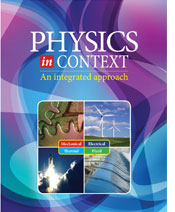
Physics in Context - 2nd Edition
Chapter 6: Power

After viewing a link, close the browser window to return
to this page.
Some links are repeated for use with more than one lesson.
Please report broken links to Kathy Kral
Choose a system and follow the links.
Mechanical |
Fluid |
Electrical |
6.1 Power in Mechanical Systems
Power
http://www.physicsclassroom.com/class/energy/U5L1e
These are the Physics Classroom lessons on power, and includes questions for a self-check of your understanding.
How
Horsepower Works
http://howstuffworks.com/horsepower.htm
A site that describes horsepower and how it is measured and compares
the horsepower in various high-performance car engines.
How
Force, Power, Torque, and Energy Work
http://www.howstuffworks.com/fpte.htm
Visit this site for a refresher on mass, force, torque, work,
and energy and to learn about power. Includes examples.
Human Power Generators
http://windstreampower.com/
Explore the products and their applications from this company, specializing in human power generation in remote locales. How much power can a human really deliver?
James Watt
http://www.egr.msu.edu/~lira/supp/steam/wattbio.html
A short biography of James Watt's contribution to the development of the steam engine, and the unit of horsepower which we still see used today.
Work,
Energy, Power
http://hyperphysics.phy-astr.gsu.edu/hbase/work.html#wep
Part of the HyperPhysics site from Georgia State University. It
defines work, energy, and power. Follow the "power concepts" links to learn
more about power.
The
Science of Hockey
http://www.exploratorium.edu/hockey/index.html
This site on the science of hockey includes calculations in the
section on checking for force and energy. It includes a calculation to determine
how long a 60-watt bulb could be burned with the energy generated.
6.2 Power in Fluid Systems
The
Nature of Water Power
http://www.fwee.org/TG/curriculum.html
A site on water and hydroelectric power that includes several
activities for students to perform to help them learn more about issues related
to hydroelectric power plants
Pneumatics
Online Calculator
http://www.pneumaticsonline.com/calculator.htm
This site provides links to online calculators for cylinder bore,
cylinder force, and valve flow in metric or imperial units.
Internet Glossary of Pumps
http://www.pumpfundamentals.com/pump_glossary.htm
A very comprehensive (and lengthy) accumulation of information about pumps and pump design, and measurements, including many illustrations and animations of different pumps, measurements, and so forth. Several entries give facts about flow rates and historical info about the various pump designs.
Pump-Zone.com
http://www.pump-zone.com
The online site for Pumps and Systems magazine. Provides many journal
quality articles relating to pumps. Check current and archived articles
(requires painless user registration).
What Is Fluid Power?
http://www.nfpa.com/fluidpower/whatisfluidpower.aspx
This page from the National Fluid Power Association provides an overview of fluid power, including facts and terminology related to fluid power, as well as links to data and employment opportunities related to fluid power.
Hydraulic Symbols Tutorial
http://www.wikiplc.com/index.php/articles/fluid-power/31-hydraulics-tutorial
A pictorial listing and explanation of symbols used in hydraulic schematics, and basic formulas used in hydraulic calculations.
6.3 Power in Electrical Systems
DC
Electric Power
http://hyperphysics.phy-astr.gsu.edu/hbase/electric/elepow.html#c1
A page from the Georgia State University HyperPhysics site that
provides tools for determining DC electric power and discusses power dissipated
in a resistor
Electrical Power: Sources and Transmission
http://tcipg.mste.illinois.edu/applet/The+Power+Grid
This interactive applet demonstrates how a typical power grid gets its
power and distributes it to many types of consumers. See links to Challenges
and Resources for Students and Teachers for ways to learn from this applet. (Requires Java.)
Wind Power
http://www.blm.gov/wo/st/en/prog/energy/wind_energy.html
This U.S. government page discusses the use of wind to generate electrical power,
the fastest growing source of electricity worldwide, as well as links to
discussions of other energy sources. See also
http://energy.gov/eere/wind/wind-program
Electric Power Distribution
http://science.howstuffworks.com/environmental/energy/power.htm
This series of pages conveys an understanding of the many ways electric power is distributed, including a light discussion of alternating current, three-phase, and line voltage.
How High-Voltage DC Transmission Works
http://www.cleanlineenergy.com/technology/hvdc/how
This site explores a growing alternative for power transmission over long distances using DC rather than AC, including a video.
How Electric Power Meters Work
http://blog.gridium.com/1504/how-stuff-works-an-old-meter/
This site includes a well-done video showing the disassembly of an old-style electric power meter, that reveals how the meter uses a 100-year-old design to accurately measure and display each customer’s usage.
Energy Saving Tips
http://energy.gov/public-services/homes/saving-electricity
This U.S. government site gives several links to help reducing electricity costs in your home, and links to other helpful energy solutions like reading the old-style electric power meter and switching to energy-efficient appliances and light bulbs.
Appliance Standards Awareness Project (ASAP)
http://www.appliance-standards.org
This site includes many links and articles discussing standards to improve the energy efficiency of major household appliances and the potential savings in terms of energy costs.
How the Power Grid Works
https://www.choosetexaspower.org/how-the-power-grid-works/
Using simple graphics, this site conveys how the nation’s power grid is structured, and how it delivers the usable voltages to us.
- https://www.youtube.com/v/iattHLRbE0Y (video about our Power Grid)
- https://www.eia.gov/tools/faqs/faq.cfm?id=427&t=3 (page listing current energy generation sources and stats)
- https://www.youtube.com/v/5wF03-bqyJo (conceptual video about the evolution of our Power Grid)
- http://science.howstuffworks.com/environmental/energy/power.htm (How Power Grids Work)
- https://www.smartgrid.gov/the_smart_grid/plugin_electric_vehicles.html (applying smart-grid technology to the charging of electric cars)
